概述
产品名称
p53 Mouse Monoclonal Antibody [C8-A11]
抗体类型
Mouse Monoclonal Antibody
免疫原
Synthetic peptide within Human p53 aa 344-393.
种属反应性
Human
验证应用
WB, IF-Cell, IHC-P
分子量
Predicted band size: 53 kDa
阳性对照
293 cell lysates, A431, human liver carcinoma tissue.
偶联
unconjugated
克隆号
C8-A11
RRID
产品特性
形态
Liquid
存放说明
Shipped at 4℃. Store at +4℃ short term (1-2 weeks). It is recommended to aliquot into single-use upon delivery. Store at -20℃ long term.
存储缓冲液
1*PBS (pH7.4), 0.2% BSA, 40% Glycerol. Preservative: 0.05% Sodium Azide.
亚型
IgG1
纯化方式
Protein G affinity purified.
应用稀释度
-
IF-Cell
-
1:200- 1:1,000
-
IHC-P
-
1:200
-
WB
-
1:500
发表文章中的应用
| WB | 查看 6 篇文献如下 |
| IHC-P | 查看 1 篇文献如下 |
发表文章中的种属
| Mouse | 查看 6 篇文献如下 |
靶点
功能
Cellular tumor antigen p53 is crucial in multicellular organisms, where it regulates the cell cycle and, thus, functions as a tumor suppressor, preventing cancer. As such, p53 has been described as "the guardian of the genome" because of its role in conserving stability by preventing genome mutation. Activated p53 binds DNA and activates expression of several genes including microRNA miR-34a, WAF1/CIP1 encoding for p21 and hundreds of other down-stream genes. p21 (WAF1) binds to the G1-S/CDK (CDK2) and S/CDK complexes (molecules important for the G1/S transition in the cell cycle) inhibiting their activity. p53 expression can be stimulated by UV light, which also causes DNA damage. In this case, p53 can initiate events leading to tanning.
背景文献
1. "p53 and human cancer: the first ten thousand mutations." Hainaut P., Hollstein M. Adv. Cancer Res. 77:81-137(2000)
2. "Impact of mutant p53 functional properties on TP53 mutation patterns and tumor phenotype: lessons from recent developments in the IARC TP53 database." Petitjean A., Mathe E., Kato S., Ishioka C., Tavtigian S.V., Hainaut P., Olivier M. Hum. Mutat. 28:622-629(2007) "Stabilising the DNA-binding domain of p53 by rational design of its hydrophobic core." Khoo K.H., Joerger A.C., Freund S.M., Fersht A.R. Protein Eng. Des. Sel. 22:421-430(2009)
序列相似性
Belongs to the p53 family.
组织特异性
Ubiquitous. Isoforms are expressed in a wide range of normal tissues but in a tissue-dependent manner. Isoform 2 is expressed in most normal tissues but is not detected in brain, lung, prostate, muscle, fetal brain, spinal cord and fetal liver. Isoform 3 is expressed in most normal tissues but is not detected in lung, spleen, testis, fetal brain, spinal cord and fetal liver. Isoform 7 is expressed in most normal tissues but is not detected in prostate, uterus, skeletal muscle and breast. Isoform 8 is detected only in colon, bone marrow, testis, fetal brain and intestine. Isoform 9 is expressed in most normal tissues but is not detected in brain, heart, lung, fetal liver, salivary gland, breast or intestine.
翻译后修饰
Acetylated. Acetylation of Lys-382 by CREBBP enhances transcriptional activity. Deacetylation of Lys-382 by SIRT1 impairs its ability to induce proapoptotic program and modulate cell senescence. Deacetylation by SIRT2 impairs its ability to induce transcription activation in a AKT-dependent manner.; Phosphorylation on Ser residues mediates transcriptional activation. Phosphorylated by HIPK1 (By similarity). Phosphorylation at Ser-9 by HIPK4 increases repression activity on BIRC5 promoter. Phosphorylated on Thr-18 by VRK1. Phosphorylated on Ser-20 by CHEK2 in response to DNA damage, which prevents ubiquitination by MDM2. Phosphorylated on Ser-20 by PLK3 in response to reactive oxygen species (ROS), promoting p53/TP53-mediated apoptosis. Phosphorylated on Thr-55 by TAF1, which promotes MDM2-mediated degradation. Phosphorylated on Ser-33 by CDK7 in a CAK complex in response to DNA damage. Phosphorylated on Ser-46 by HIPK2 upon UV irradiation. Phosphorylation on Ser-46 is required for acetylation by CREBBP. Phosphorylated on Ser-392 following UV but not gamma irradiation. Phosphorylated on Ser-15 upon ultraviolet irradiation; which is enhanced by interaction with BANP. Phosphorylated by NUAK1 at Ser-15 and Ser-392; was initially thought to be mediated by STK11/LKB1 but it was later shown that it is indirect and that STK11/LKB1-dependent phosphorylation is probably mediated by downstream NUAK1. It is unclear whether AMP directly mediates phosphorylation at Ser-15. Phosphorylated on Thr-18 by isoform 1 and isoform 2 of VRK2. Phosphorylation on Thr-18 by isoform 2 of VRK2 results in a reduction in ubiquitination by MDM2 and an increase in acetylation by EP300. Stabilized by CDK5-mediated phosphorylation in response to genotoxic and oxidative stresses at Ser-15, Ser-33 and Ser-46, leading to accumulation of p53/TP53, particularly in the nucleus, thus inducing the transactivation of p53/TP53 target genes. Phosphorylated by DYRK2 at Ser-46 in response to genotoxic stress. Phosphorylated at Ser-315 and Ser-392 by CDK2 in response to DNA-damage. Phosphorylation at Ser-15 is required for interaction with DDX3X and gamma-tubulin.; Dephosphorylated by PP2A-PPP2R5C holoenzyme at Thr-55. SV40 small T antigen inhibits the dephosphorylation by the AC form of PP2A.; May be O-glycosylated in the C-terminal basic region. Studied in EB-1 cell line.; Ubiquitinated by MDM2 and SYVN1, which leads to proteasomal degradation. Ubiquitinated by RFWD3, which works in cooperation with MDM2 and may catalyze the formation of short polyubiquitin chains on p53/TP53 that are not targeted to the proteasome. Ubiquitinated by MKRN1 at Lys-291 and Lys-292, which leads to proteasomal degradation. Deubiquitinated by USP10, leading to its stabilization. Ubiquitinated by TRIM24, RFFL, RNF34 and RNF125, which leads to proteasomal degradation. Ubiquitination by TOPORS induces degradation. Deubiquitination by USP7, leading to stabilization. Isoform 4 is monoubiquitinated in an MDM2-independent manner. Ubiquitinated by COP1, which leads to proteasomal degradation. Ubiquitination and subsequent proteasomal degradation is negatively regulated by CCAR2. Polyubiquitinated by C10orf90/FATS, polyubiquitination is 'Lys-48'-linkage independent and non-proteolytic, leading to TP53 stabilization (By similarity).; Monomethylated at Lys-372 by SETD7, leading to stabilization and increased transcriptional activation. Monomethylated at Lys-370 by SMYD2, leading to decreased DNA-binding activity and subsequent transcriptional regulation activity. Lys-372 monomethylation prevents interaction with SMYD2 and subsequent monomethylation at Lys-370. Dimethylated at Lys-373 by EHMT1 and EHMT2. Monomethylated at Lys-382 by KMT5A, promoting interaction with L3MBTL1 and leading to repress transcriptional activity. Dimethylation at Lys-370 and Lys-382 diminishes p53 ubiquitination, through stabilizing association with the methyl reader PHF20. Demethylation of dimethylated Lys-370 by KDM1A prevents interaction with TP53BP1 and represses TP53-mediated transcriptional activation. Monomethylated at Arg-333 and dimethylated at Arg-335 and Arg-337 by PRMT5; methylation is increased after DNA damage and might possibly affect TP53 target gene specificity.; Sumoylated with SUMO1. Sumoylated at Lys-386 by UBC9.
亚细胞定位
Cytoplasm, nucleus
UNIPROT
别名
Antigen NY-CO-13 antibody
BCC7 antibody
Cellular tumor antigen p53 antibody
FLJ92943 antibody
LFS1 antibody
Mutant tumor protein 53 antibody
p53 antibody
p53 tumor suppressor antibody
P53_HUMAN antibody
Phosphoprotein p53 antibody
展开Antigen NY-CO-13 antibody
BCC7 antibody
Cellular tumor antigen p53 antibody
FLJ92943 antibody
LFS1 antibody
Mutant tumor protein 53 antibody
p53 antibody
p53 tumor suppressor antibody
P53_HUMAN antibody
Phosphoprotein p53 antibody
Tp53 antibody
Transformation related protein 53 antibody
TRP53 antibody
Tumor protein 53 antibody
Tumor protein p53 antibody
Tumor suppressor p53 antibody
折叠图片
-

Western blot analysis on 293 cell lysates using anti- p53 mouse mAb.
-

Immunocytochemistry analysis of A431 cells labeling p53 with Mouse anti-p53 antibody (M1312-2) at 1/200 dilution.
Cells were fixed in 4% paraformaldehyde for 15 minutes at room temperature, permeabilized with 0.1% Triton X-100 in PBS for 15 minutes at room temperature, then blocked with 1% BSA in 10% negative goat serum for 1 hour at room temperature. Cells were then incubated with Mouse anti-p53 antibody (M1312-2) at 1/200 dilution in 1% BSA in PBST overnight at 4 ℃. Goat Anti-Mouse IgG H&L (iFluor™ 488, HA1125) was used as the secondary antibody at 1/1,000 dilution. PBS instead of the primary antibody was used as the secondary antibody only control. Nuclear DNA was labelled in blue with DAPI.
beta Tubulin (ET1602-4, red) was stained at 1/100 dilution overnight at +4℃. Goat Anti-Rabbit IgG H&L (iFluor™ 594, HA1122) were used as the secondary antibody at 1/1,000 dilution. -

Immunohistochemical analysis of paraffin-embedded human liver carcinoma tissue using anti- p53 mouse monoclonal antibody.
请注意: All products are "FOR RESEARCH USE ONLY AND ARE NOT INTENDED FOR DIAGNOSTIC OR THERAPEUTIC USE"
引文
-
Toxoplasma gondii induces MLTC-1 apoptosis via ERS pathway
Author:
PMID: 36403802
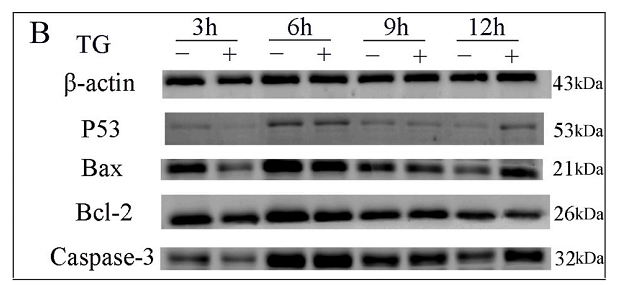
期刊: Experimental Parasitology
应用: WB
反应种属: Mouse
发表时间: 2023 Jan
-
Citation
-
Synergistic Effects of Folic Acid and n-3 Polyunsaturated Fatty Acid in Preventing Neural Tube Defects in Diabetic Mice
Author:
PMID: 36039894
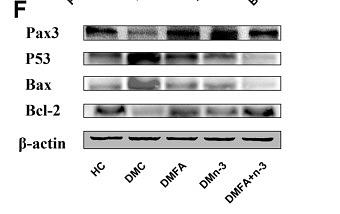
期刊: Journal Of Agricultural And Food Chemistry
应用: WB
反应种属: Mouse
发表时间: 2022 Sep
-
Citation
-
BNC1 deficiency-triggered ferroptosis through the NF2-YAP pathway induces primary ovarian insufficiency
Author: Wang, F., Liu, Y., Ni, F., Jin, J., Wu, Y., Huang, Y., Ye, X., Shen, X., Ying, Y., Chen, J., Chen, R., Zhang, Y., Sun, X., Wang, S., Xu, X., Chen, C., Guo, J., & Zhang, D.
PMID: 36198708
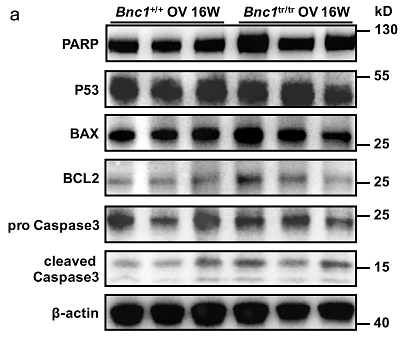
期刊: Nature Communications
应用: WB
反应种属: Mouse
发表时间: 2022 Oct
-
Citation
-
FFAR4 improves the senescence of tubular epithelial cells by AMPK/SirT3 signaling in acute kidney injury
Author: Yang, L., Wang, B., Guo, F., Huang, R., Liang, Y., Li, L., Tao, S., Yin, T., Fu, P., & Ma, L.
PMID: 36450712
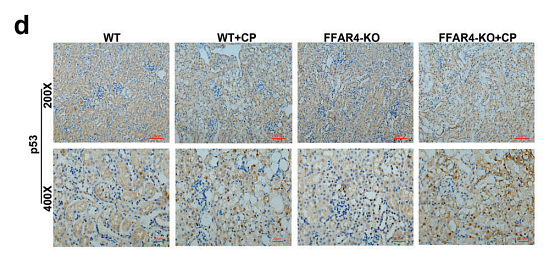
期刊: Signal Transduction And Targeted Therapy
应用: WB,IHC-P
反应种属: Mouse
发表时间: 2022 Nov
-
Citation
-
N-3 polyunsaturated fatty acids effectively protect against neural tube defects in diabetic mice induced by streptozotocin
Author: Li, K., Shi, Y., Zhu, S., Shao, X., Li, H., Kuang, X., Li, S., Guo, X. F., & Li, D.
PMID: 34606561
期刊: Food & Function
应用: WB
反应种属: Mouse
发表时间: 2021 Oct
-
Citation
-
Luman/CREB3 knock-down inhibit hCG induced MLTC-1 apoptosis
Author: Wang, L., Meng, Q., Yang, L., Yang, D., Guo, W., Lin, P., Chen, H., Tang, K., Wang, A., & Jin, Y.
PMID: 33310232
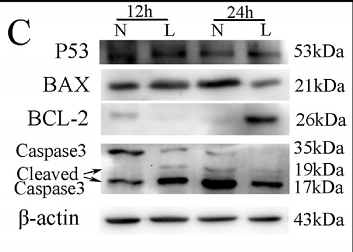
期刊: Theriogenology
应用: WB
反应种属: Mouse
发表时间: 2021 Feb
-
Citation
同靶点 & 同通路的产品
p53 (acetyl K370) Recombinant Rabbit Monoclonal Antibody [SR40-09]
Application: WB,IF-Cell,IF-Tissue,FC
Reactivity: Human,Mouse,Rat
Conjugate: unconjugated
Phospho-p53 (S376) Recombinant Rabbit Monoclonal Antibody [ST0440]
Application: WB
Reactivity: Human,Mouse
Conjugate: unconjugated
p53 Mouse Monoclonal Antibody [6B2]
Application: WB,IF-Cell
Reactivity: Human,Mouse
Conjugate: unconjugated
Phospho-p53 (S33) Recombinant Rabbit Monoclonal Antibody [JE41-97]
Application: WB,IF-Cell,IHC-P
Reactivity: Human,Mouse,Rat
Conjugate: unconjugated
p53 Mouse Monoclonal Antibody [6B5]
Application: WB
Reactivity: Human
Conjugate: unconjugated
p53 (acetyl K382) Recombinant Rabbit Monoclonal Antibody [SD0801]
Application: WB,IF-Cell,IHC-P
Reactivity: Human,Mouse
Conjugate: unconjugated
p53 (acetyl K382) Recombinant Rabbit Monoclonal Antibody [PSH06-88] - BSA and Azide free
Application: WB,IF-Cell
Reactivity: Human
Conjugate: unconjugated
Phospho-p53 (T55) Recombinant Rabbit Monoclonal Antibody [ST0439]
Application: WB,IHC-P
Reactivity: Human
Conjugate: unconjugated
p53 Recombinant Mouse Monoclonal Antibody [6B2-R]
Application: WB,IF-Cell
Reactivity: Human,Monkey
Conjugate: unconjugated
Phospho-p53 (S392) Recombinant Rabbit Monoclonal Antibody [SI17-04] - BSA and Azide free
Application: WB,IHC-P,IP
Reactivity: Human,Mouse,Rat
Conjugate: unconjugated
p53 Recombinant Mouse Monoclonal Antibody [6B2-R] - BSA and Azide free
Application: WB,IF-Cell
Reactivity: Human,Monkey
Conjugate: unconjugated
Phospho-p53 (S15) Recombinant Rabbit Monoclonal Antibody [PSH01-98] - BSA and Azide free
Application: WB,IF-Cell
Reactivity: Human
Conjugate: unconjugated
p53 Recombinant Rabbit Monoclonal Antibody [SA39-07] - BSA and Azide free
Application: WB,IF-Cell,ChIP
Reactivity: Human
Conjugate: unconjugated
p53 (acetyl K370) Recombinant Rabbit Monoclonal Antibody [SR40-09] - BSA and Azide free
Application: WB,IF-Cell,IF-Tissue,FC
Reactivity: Human,Mouse,Rat
Conjugate: unconjugated
p53 Mouse Monoclonal Antibody [7-5]
Application: WB,IF-Cell,IHC-P,FC
Reactivity: Human
Conjugate: unconjugated
p53 Rabbit Polyclonal Antibody
Application: WB,IF-Cell
Reactivity: Human
Conjugate: unconjugated
p53 Recombinant Rabbit Monoclonal Antibody [JB42-26]
Application: WB,IHC-P,FC,IP,IF-Cell,IF-Tissue
Reactivity: Human
Conjugate: unconjugated
p53 Recombinant Mouse Monoclonal Antibody [6B5-R] - BSA and Azide free
Application: WB,IF-Cell
Reactivity: Human,Mouse,Monkey
Conjugate: unconjugated
p53 Recombinant Rabbit Monoclonal Antibody [PD01-32] - BSA and Azide free
Application: IHC-P
Reactivity: Human
Conjugate: unconjugated
p53 (acetyl K382) Recombinant Rabbit Monoclonal Antibody [PSH06-87] - BSA and Azide free
Application: WB,IF-Cell
Reactivity: Human,Mouse
Conjugate: unconjugated
Phospho-p53 (S392) Recombinant Rabbit Monoclonal Antibody [SI17-04]
Application: WB,IHC-P,IP
Reactivity: Human,Mouse,Rat
Conjugate: unconjugated
p53 Recombinant Mouse Monoclonal Antibody [6B5-R]
Application: WB,IF-Cell
Reactivity: Human,Mouse,Monkey
Conjugate: unconjugated
Phospho-p53 (S20) Recombinant Rabbit Monoclonal Antibody [PSH06-86] - BSA and Azide free
Application: WB
Reactivity: Human
Conjugate: unconjugated
p53 (acetyl K382) Recombinant Rabbit Monoclonal Antibody [PSH06-88]
Application: WB,IF-Cell
Reactivity: Human
Conjugate: unconjugated
Phospho-p53 (S15) Recombinant Rabbit Monoclonal Antibody [PSH01-98]
Application: WB,IF-Cell
Reactivity: Human
Conjugate: unconjugated
p53 (acetyl K382) Recombinant Rabbit Monoclonal Antibody [PSH06-87]
Application: WB,IF-Cell
Reactivity: Human,Mouse
Conjugate: unconjugated
p53 Recombinant Rabbit Monoclonal Antibody [SY010-6]
Application: WB,IF-Cell,IF-Tissue,IHC-P,IP,FC
Reactivity: Human
Conjugate: unconjugated
Phospho-p53 (S20) Recombinant Rabbit Monoclonal Antibody [PSH06-86]
Application: WB
Reactivity: Human
Conjugate: unconjugated
p53 Recombinant Rabbit Monoclonal Antibody [PD01-32]
Application: IHC-P
Reactivity: Human
Conjugate: unconjugated
p53 Recombinant Rabbit Monoclonal Antibody [SA39-07]
Application: WB,IF-Cell,ChIP
Reactivity: Human
Conjugate: unconjugated

































